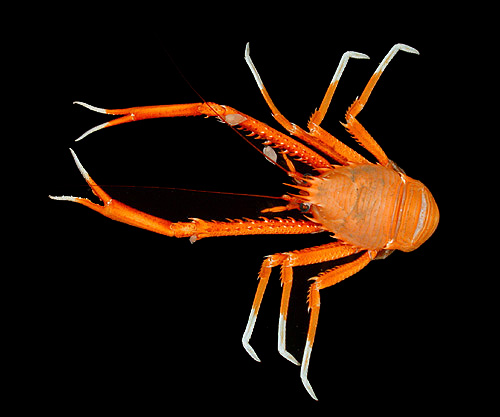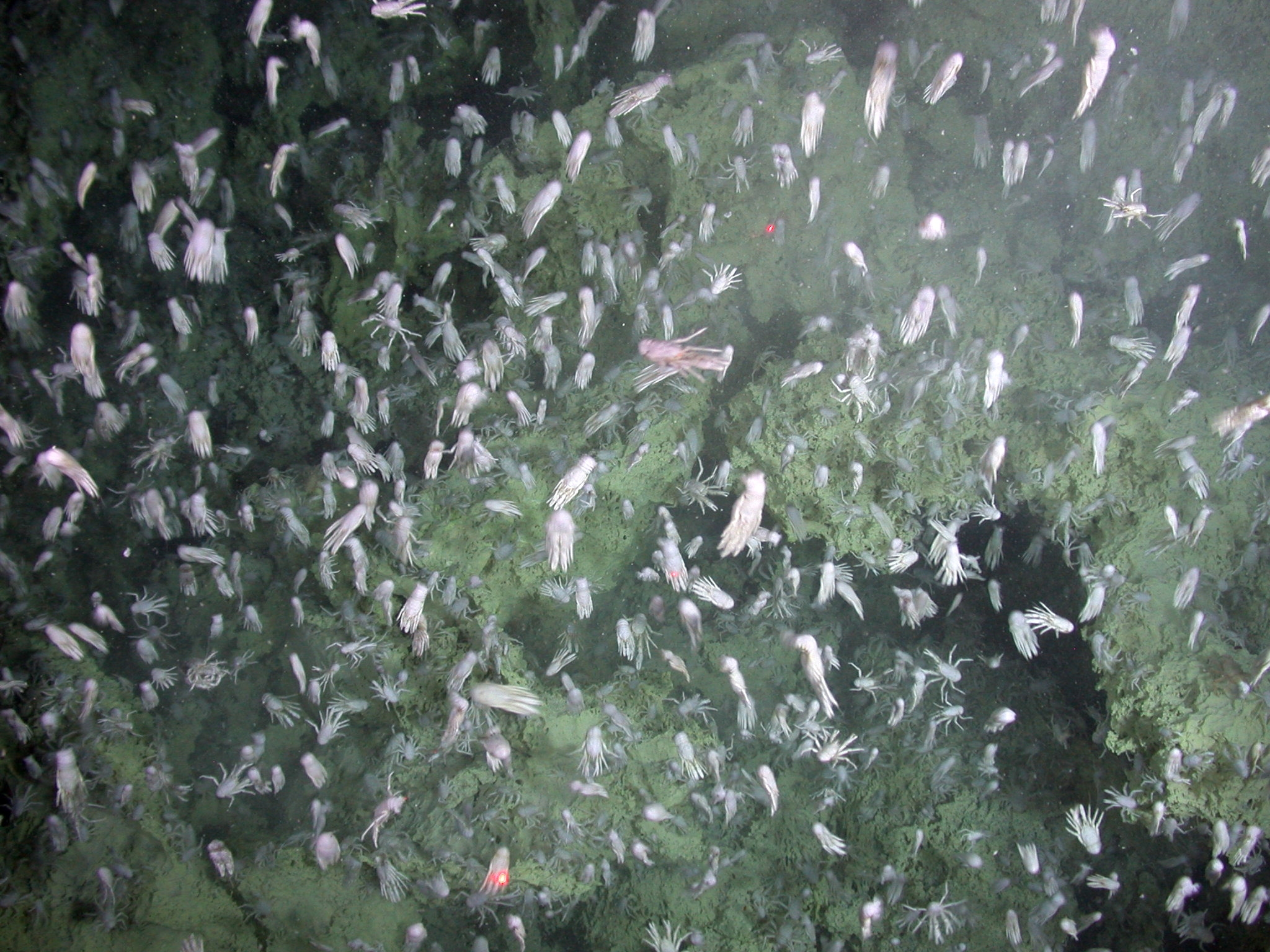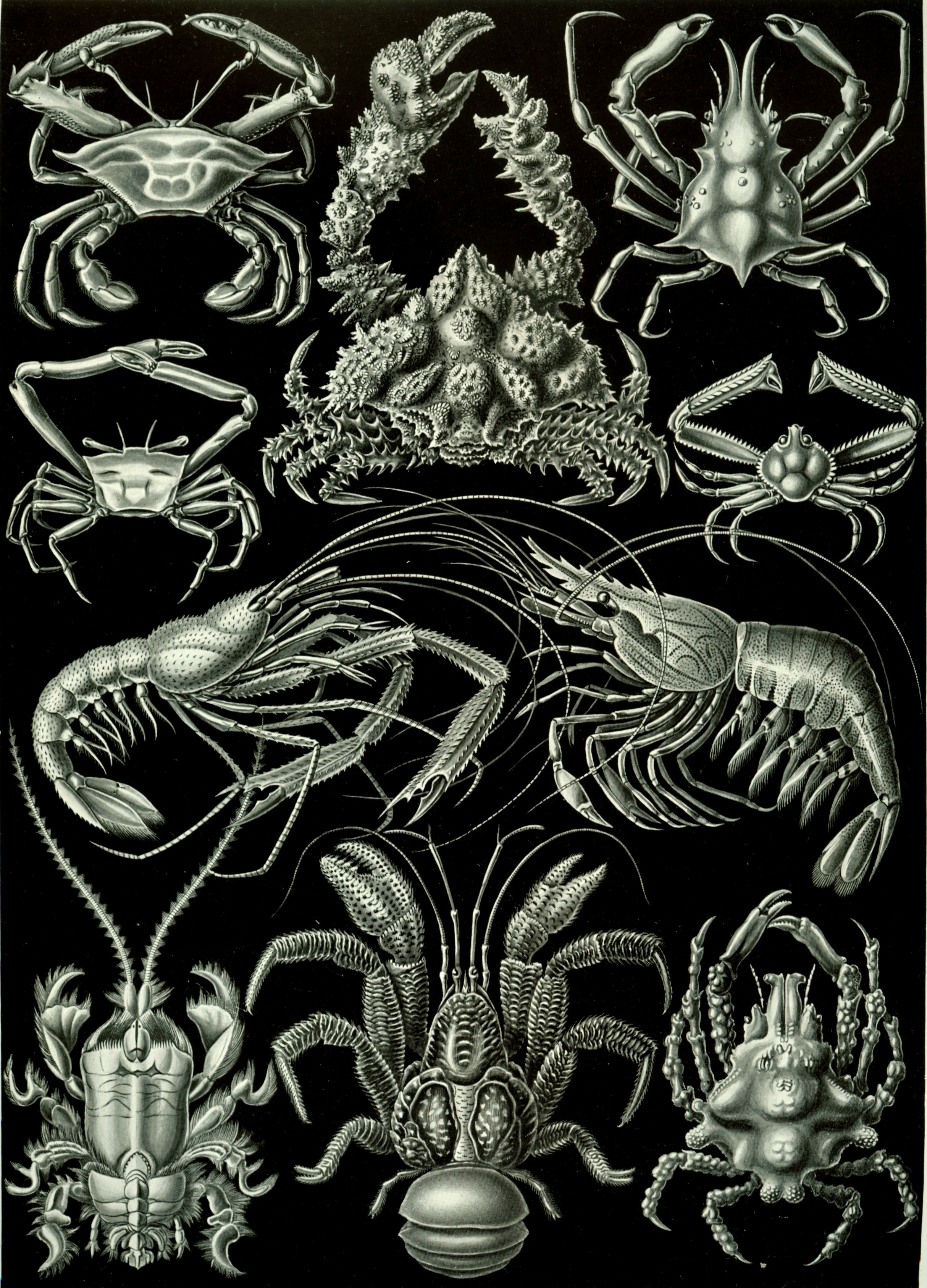|
Paguroidea
Hermit crabs are anomuran decapod crustaceans of the superfamily Paguroidea that have adapted to occupy empty scavenged mollusc shells to protect their fragile exoskeletons. There are over 800 species of hermit crab, most of which possess an asymmetric abdomen concealed by a snug-fitting shell. Hermit crabs' soft (non- calcified) abdominal exoskeleton means they must occupy shelter produced by other organisms or risk being defenseless. The strong association between hermit crabs and their shelters has significantly influenced their biology. Almost 800 species carry mobile shelters (most often calcified snail shells); this protective mobility contributes to the diversity and multitude of these crustaceans which are found in almost all marine environments. In most species, development involves metamorphosis from symmetric, free-swimming larvae to morphologically asymmetric, benthic-dwelling, shell-seeking crabs. Such physiological and behavioral extremes facilitate a transition to ... [...More Info...] [...Related Items...] OR: [Wikipedia] [Google] [Baidu] |
Anomura
Anomura (sometimes Anomala) is a group of decapod crustaceans, including hermit crabs and others. Although the names of many anomurans include the word ''crab'', all true crabs are in the sister group to the Anomura, the Brachyura (the two groups together form the clade Meiura). Description The name Anomura derives from an old classification in which Reptantia, reptant decapods were divided into Macrura (long-tailed), Brachyura (short-tailed) and Anomura (differently-tailed). The alternative name Anomala reflects the unusual variety of forms in this group; whereas all crabs share some obvious similarities, the various groups of anomurans are quite dissimilar. The group has been moulded by several instances of carcinisation – the development of a crab-like body form. Thus, the king crabs (Lithodidae), porcelain crabs (Porcellanidae) and hairy stone crab (Lomisidae) are all separate instances of carcinisation. As decapods (meaning ''ten-legged''), anomurans have ten pereiopods, ... [...More Info...] [...Related Items...] OR: [Wikipedia] [Google] [Baidu] |
Pylochelidae
The Pylochelidae are a family (biology), family of hermit crabs. Its members are commonly called the 'symmetrical hermit crabs'. They live in all the world's oceans, except the Arctic and the Antarctic, at depths of . Due to their crypsis, cryptic nature and relative scarcity, only around 60 specimens had been collected before 1987, when a monograph was published detailing a further 400. Description Unlike other hermit crabs, pylochelid hermit crabs are not markedly asymmetrical, with a straight body and equal numbers of appendages on both sides. This characteristic, together with the partial calcification of the abdomen (which is soft in other hermit crabs) led Edward J. Miers, when describing the first species, to consider it to represent a transition between hermit crabs and "Macrura" (long-tailed Decapoda, decapods, such as lobsters and shrimp). Correspondingly, pylochelid hermit crabs do not usually inhabit gastropod shells, but instead withdraw into decayed pieces of wood, ... [...More Info...] [...Related Items...] OR: [Wikipedia] [Google] [Baidu] |
Pagurid
The Paguridae are a family of hermit crabs of the order Decapoda The Decapoda or decapods, from Ancient Greek δεκάς (''dekás''), meaning "ten", and πούς (''poús''), meaning "foot", is a large order of crustaceans within the class Malacostraca, and includes crabs, lobsters, crayfish, shrimp, a .... The king crabs, Lithodidae, are now widely understood to be derived from deep within the Paguridae, with some authors placing their ancestors within the genus ''Pagurus''. List This family contains the following genera: References External links * * Hermit crabs Taxa named by Pierre André Latreille Decapod families {{Anomura-stub ... [...More Info...] [...Related Items...] OR: [Wikipedia] [Google] [Baidu] |
Pylojacquesidae
The Pylojacquesidae are a small family of hermit crabs, comprising only two monotypic genera. The family was erected in 2001, after two specimens at ''Museum für Naturkunde'' at the Humboldt University of Berlin were recognised as being quite distinct from other described hermit crabs. The family members differ from other hermit crabs in that their mandibles are chitinous and toothed. ''Pylojacquesia'' ''Pylojacquesia'' is monotypic, the sole species being ''Pylojacquesia colemani''. It was described in 2001, based on two specimens discovered in the . The specimens had been collected in 1875 by the S.M.S. ''Gazelle'' at in the Coral Sea, off the coast of Brisbane, Australia. It lives in the tubes secreted by serpulid worms of the genus '' Protula'' (Annelida: Serpulidae) in sandy areas of the continental shelf. The specific name commemorates Charles Oliver Coleman, curator of Crustacea at the . ''Lemaitreopsis'' ''Lemaitreopsis'' is monotypic, the sole species being ''Lemait ... [...More Info...] [...Related Items...] OR: [Wikipedia] [Google] [Baidu] |
Calcinidae
The Diogenidae are a family (biology), family of hermit crabs, sometimes known as "left-handed hermit crabs" because in contrast to most other hermit crabs, its left chela (organ), chela (claw) is enlarged instead of the right. It comprises 429 extant species, and a further 46 extinct species, making it the second-largest family of marine hermit crabs, after the Paguridae. Genera File:Aniculus ursus.JPG, ''Aniculus ursus'' File:Calcinus elegans Réunion.jpg, ''Calcinus elegans'' File:Ciliopagurus strigatus Réunion.JPG, ''Ciliopagurus strigatus'' File:Clibanarius.jpg, ''Clibanarius erythropus'' File:Dardanus megistos Réunion.jpg, ''Dardanus megistos'' File:Diogenes pugilator.jpg, ''Diogenes pugilator'' File:Paguristes cadenati.jpg, ''Paguristes cadenati'' File:Petrochirus diogenes 1.jpg, ''Petrochirus diogenes'' File:Strigopagurus strigimanus P2133407.JPG, ''Strigopagurus strigimanus'' References External links * * * Diogenidae, Decapod families Taxa named by ... [...More Info...] [...Related Items...] OR: [Wikipedia] [Google] [Baidu] |
Coenobitidae
The Coenobitidae are the family of terrestrial hermit crabs, widely known for their land-living habits as adults. They are found in coastal tropical The tropics are the regions of Earth surrounding the equator, where the sun may shine directly overhead. This contrasts with the temperate or polar regions of Earth, where the Sun can never be directly overhead. This is because of Earth's ax ... regions around the world and require access to the ocean to breed. Although coenobitids are fully terrestrial as adults, they spend their marine life as planktonic larvae. Female coenobitids return to the sea to hatch their eggs and their larvae develop through planktonic zoeal stages to a megalopa, in a similar way as the marine hermit crabs. Just like these species, after settlement, terrestrial hermit crabs megalopae recognize and co-opt gastropods shells, before migrating into the land and molting to the first crab stage. The 17 species are placed in two genera: References * H ... [...More Info...] [...Related Items...] OR: [Wikipedia] [Google] [Baidu] |
Diogenidae
The Diogenidae are a family of hermit crabs, sometimes known as "left-handed hermit crabs" because in contrast to most other hermit crabs, its left chela (claw) is enlarged instead of the right. It comprises 429 extant species, and a further 46 extinct species, making it the second-largest family of marine hermit crabs, after the Paguridae. Genera File:Aniculus ursus.JPG, '' Aniculus ursus'' File:Calcinus elegans Réunion.jpg, ''Calcinus elegans ''Calcinus elegans'', also known as the blue line hermit crab, is a small, tropical hermit crab. Description It features the typical body plan of a member of the phylum Arthropoda: a segmented head, a thorax, and an abdomen. As a member of order ...'' File:Ciliopagurus strigatus Réunion.JPG, '' Ciliopagurus strigatus'' File:Clibanarius.jpg, '' Clibanarius erythropus'' File:Dardanus megistos Réunion.jpg, '' Dardanus megistos'' File:Diogenes pugilator.jpg, '' Diogenes pugilator'' File:Paguristes cadenati.jpg, '' Paguristes caden ... [...More Info...] [...Related Items...] OR: [Wikipedia] [Google] [Baidu] |
Squat Lobster
Squat lobsters are dorsoventrally flattened crustaceans with long tails held curled beneath the cephalothorax. They are found in the two superfamilies Galatheoidea and Chirostyloidea, which form part of the decapod infraorder Anomura, alongside groups including the hermit crabs and mole crabs. They are distributed worldwide in the oceans, and occur from near the surface to deep sea hydrothermal vents, with one species occupying caves above sea level. More than 900 species have been described, in around 60 genera. Some species form dense aggregations, either on the sea floor or in the water column, and a small number are commercially fished. Description The two main groups of squat lobsters share most features of their morphology. They resemble true lobsters in some ways, but are somewhat flattened dorsoventrally, and are typically smaller, ranging from 0.7 to 3.5 inches in length. Squat lobsters vary in postorbital carapace length (measured from the eye socket to the r ... [...More Info...] [...Related Items...] OR: [Wikipedia] [Google] [Baidu] |
Decapoda
The Decapoda or decapods, from Ancient Greek δεκάς (''dekás''), meaning "ten", and πούς (''poús''), meaning "foot", is a large order of crustaceans within the class Malacostraca, and includes crabs, lobsters, crayfish, shrimp, and prawns. Most decapods are scavengers. The order is estimated to contain nearly 15,000 extant species in around 2,700 genera, with around 3,300 fossil species. Nearly half of these species are crabs, with the shrimp (about 3,000 species) and Anomura including hermit crabs, king crabs, porcelain crabs, squat lobsters (about 2500 species) making up the bulk of the remainder. The earliest fossils of the group date to the Devonian. Anatomy Decapods can have as many as 38 appendages, arranged in one pair per body segment. As the name Decapoda (from the Greek , ', "ten", and , '' -pod'', "foot") implies, ten of these appendages are considered legs. They are the pereiopods, found on the last five thoracic segments. In many decapods, one ... [...More Info...] [...Related Items...] OR: [Wikipedia] [Google] [Baidu] |
Dardanus Calidus
''Dardanus calidus'' is a species of hermit crab from the East Atlantic (Portugal to Senegal) and Mediterranean Sea. Description ''D. calidus'' can grow to a length of . It uses large gastropod shells, such as those of '' Tonna galea'' and '' Charonia'' species, which it often decorates with one or more sea anemones of the species '' Calliactis parasitica''. The relationship with the anemone is truly symbiotic, since the anemone gains scraps of food from the hermit crab, while the crab benefits from the anemone's stinging tentacles deterring predators. Distribution and ecology ''Dardanus calidus'' is a scavenger, feeding on decaying matter from the sea bed. It has been collected from depths greater than , but is more typically found in shallower water. Taxonomic history ''Dardanus calidus'' was first described by Antoine Risso Giuseppe Antonio Risso (8 April 1777 – 25 August 1845), called Antoine Risso, was a naturalist from Nice. Risso was born in the city of Nice in th ... [...More Info...] [...Related Items...] OR: [Wikipedia] [Google] [Baidu] |




